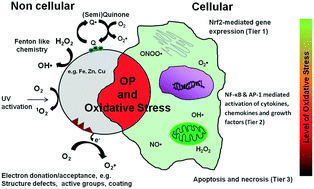当前位置:
X-MOL 学术
›
Environ. Sci.: Nano
›
论文详情
Our official English website, www.x-mol.net, welcomes your
feedback! (Note: you will need to create a separate account there.)
Analytical methods to assess the oxidative potential of nanoparticles: a review
Environmental Science: Nano ( IF 5.8 ) Pub Date : 2017-08-30 00:00:00 , DOI: 10.1039/c7en00346c Bryan Hellack 1, 2, 3 , Carmen Nickel 1, 2, 3 , Catrin Albrecht 3, 4, 5 , Thomas A. J. Kuhlbusch 3, 6, 7, 8, 9 , Sonja Boland 10, 11, 12, 13 , Armelle Baeza-Squiban 10, 11, 12, 13 , Wendel Wohlleben 3, 14, 15, 16 , Roel P. F. Schins 3, 4, 5
Environmental Science: Nano ( IF 5.8 ) Pub Date : 2017-08-30 00:00:00 , DOI: 10.1039/c7en00346c Bryan Hellack 1, 2, 3 , Carmen Nickel 1, 2, 3 , Catrin Albrecht 3, 4, 5 , Thomas A. J. Kuhlbusch 3, 6, 7, 8, 9 , Sonja Boland 10, 11, 12, 13 , Armelle Baeza-Squiban 10, 11, 12, 13 , Wendel Wohlleben 3, 14, 15, 16 , Roel P. F. Schins 3, 4, 5
Affiliation

|
Materials that contain fine or nanoscale particles are already produced in large quantities and are currently re-assessed. At the same time, there is ongoing development of new and innovative nanoparticles (NPs). Risk assessment strategies for NPs are of key importance, as their impact on ecosystems and humans is still not fully understood. However, in view of the increasing variety of NPs on the market, the testing of each individual material is too time-consuming and costly. A grouping of NPs based on their intrinsic properties of concern for possible toxicological effects would be a major improvement for risk assessment. So far, no unifying intrinsic particle properties have been identified that can be used across all materials for the determination of the possible pathogenicity of NPs. The formation of reactive oxygen species by particles represents an intrinsic property. It is often referred to as “oxidative potential” (OP) and is considered a promising grouping metric as several studies demonstrated an association between (nano-)particle exposure, OP and toxicological effects. However, other studies contradict these findings and these discrepancies might be due to OP-independent differences in the physico-chemical properties of particles and differences in study design, as well as to the heterogeneity of existing OP measurement assays. In this paper, we discuss and compare different methods to determine the OP of particles, their pros and cons and their potential applicability towards improved hazard assessment and grouping of NPs.
中文翻译:

评估纳米颗粒氧化潜能的分析方法:综述
包含精细或纳米级颗粒的材料已经大量生产,目前正在重新评估。同时,正在不断开发新的和创新的纳米颗粒(NP)。NP的风险评估战略至关重要,因为它们对生态系统和人类的影响仍未得到充分了解。然而,鉴于市场上NP的种类越来越多,对每种材料的测试都非常耗时且昂贵。根据可能的毒理学影响所关注的内在性质对NP进行分组将是风险评估的重大改进。到目前为止,还没有确定统一的固有粒子特性可用于所有材料来确定NP的可能致病性。颗粒形成的活性氧物种代表了一种固有的特性。它通常被称为“氧化电位”(OP),被认为是很有前途的分组指标,因为多项研究表明,(纳米)颗粒暴露,OP和毒理学效应之间存在关联。但是,其他研究与这些发现相矛盾,这些差异可能是由于颗粒的物理化学性质与OP无关的差异以及研究设计的差异,以及现有OP测量方法的异质性所致。在本文中,我们讨论并比较了确定颗粒物OP的不同方法,它们的优缺点以及它们在改进危害评估和NP分组方面的潜在适用性。它通常被称为“氧化电位”(OP),被认为是很有前途的分组指标,因为多项研究表明,(纳米)颗粒暴露,OP和毒理学效应之间存在关联。但是,其他研究与这些发现相矛盾,这些差异可能是由于颗粒的物理化学性质与OP无关的差异以及研究设计的差异,以及现有OP测量方法的异质性所致。在本文中,我们讨论并比较了确定颗粒物OP的不同方法,它们的优缺点以及它们在改进危害评估和NP分组方面的潜在适用性。它通常被称为“氧化电位”(OP),被认为是很有前途的分组指标,因为多项研究表明,(纳米)颗粒暴露,OP和毒理学效应之间存在关联。但是,其他研究与这些发现相矛盾,这些差异可能是由于颗粒的物理化学性质与OP无关的差异以及研究设计的差异,以及现有OP测量方法的异质性所致。在本文中,我们讨论并比较了确定颗粒物OP的不同方法,它们的优缺点以及它们在改进危害评估和NP分组方面的潜在适用性。其他研究与这些发现相矛盾,这些差异可能是由于颗粒的物理化学性质与OP无关,研究设计上的差异以及现有OP测量方法的异质性所致。在本文中,我们讨论并比较了确定颗粒物OP的不同方法,它们的优缺点以及它们在改进危害评估和NP分组方面的潜在适用性。其他研究与这些发现相矛盾,这些差异可能是由于颗粒的物理化学性质与OP无关,研究设计上的差异以及现有OP测量方法的异质性所致。在本文中,我们讨论并比较了确定颗粒物OP的不同方法,它们的优缺点以及它们在改进危害评估和NP分组方面的潜在适用性。
更新日期:2017-08-30
中文翻译:

评估纳米颗粒氧化潜能的分析方法:综述
包含精细或纳米级颗粒的材料已经大量生产,目前正在重新评估。同时,正在不断开发新的和创新的纳米颗粒(NP)。NP的风险评估战略至关重要,因为它们对生态系统和人类的影响仍未得到充分了解。然而,鉴于市场上NP的种类越来越多,对每种材料的测试都非常耗时且昂贵。根据可能的毒理学影响所关注的内在性质对NP进行分组将是风险评估的重大改进。到目前为止,还没有确定统一的固有粒子特性可用于所有材料来确定NP的可能致病性。颗粒形成的活性氧物种代表了一种固有的特性。它通常被称为“氧化电位”(OP),被认为是很有前途的分组指标,因为多项研究表明,(纳米)颗粒暴露,OP和毒理学效应之间存在关联。但是,其他研究与这些发现相矛盾,这些差异可能是由于颗粒的物理化学性质与OP无关的差异以及研究设计的差异,以及现有OP测量方法的异质性所致。在本文中,我们讨论并比较了确定颗粒物OP的不同方法,它们的优缺点以及它们在改进危害评估和NP分组方面的潜在适用性。它通常被称为“氧化电位”(OP),被认为是很有前途的分组指标,因为多项研究表明,(纳米)颗粒暴露,OP和毒理学效应之间存在关联。但是,其他研究与这些发现相矛盾,这些差异可能是由于颗粒的物理化学性质与OP无关的差异以及研究设计的差异,以及现有OP测量方法的异质性所致。在本文中,我们讨论并比较了确定颗粒物OP的不同方法,它们的优缺点以及它们在改进危害评估和NP分组方面的潜在适用性。它通常被称为“氧化电位”(OP),被认为是很有前途的分组指标,因为多项研究表明,(纳米)颗粒暴露,OP和毒理学效应之间存在关联。但是,其他研究与这些发现相矛盾,这些差异可能是由于颗粒的物理化学性质与OP无关的差异以及研究设计的差异,以及现有OP测量方法的异质性所致。在本文中,我们讨论并比较了确定颗粒物OP的不同方法,它们的优缺点以及它们在改进危害评估和NP分组方面的潜在适用性。其他研究与这些发现相矛盾,这些差异可能是由于颗粒的物理化学性质与OP无关,研究设计上的差异以及现有OP测量方法的异质性所致。在本文中,我们讨论并比较了确定颗粒物OP的不同方法,它们的优缺点以及它们在改进危害评估和NP分组方面的潜在适用性。其他研究与这些发现相矛盾,这些差异可能是由于颗粒的物理化学性质与OP无关,研究设计上的差异以及现有OP测量方法的异质性所致。在本文中,我们讨论并比较了确定颗粒物OP的不同方法,它们的优缺点以及它们在改进危害评估和NP分组方面的潜在适用性。









































 京公网安备 11010802027423号
京公网安备 11010802027423号